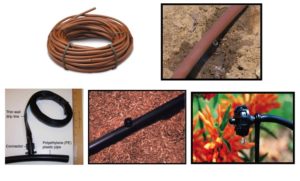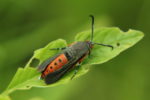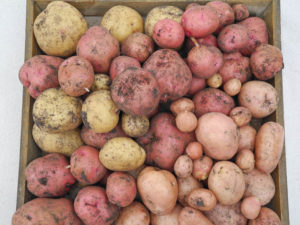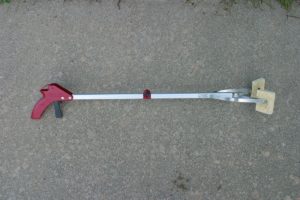Summer Season Has Arrived in the May Vegetable Garden
It’s right about now that gardeners really settle in to bragging about what they are harvesting from their garden. It can be really annoying if yours isn’t as far along or if the deer and squirrels have picked everything clean.
But if you are one of the lucky ones and are enjoying squash, cucumbers, and maybe even a tomato, pat yourself on the back. You deserve it for surviving the rough spring that we’ve had.
May is the beginning of our summer gardening season for heat loving plants. And, unfortunately, the beginning of another wave of pests ready to mow down your crop. See what is on the May vegetable garden checklist to make the most of this month.
FERTILIZE
- To keep vegetables growing vigorously fertilize lightly when the first fruit appear and again 3-4 weeks later. A general recommendation is 1 cup of organic fertilizer per 10’ of row, but please follow your soil test recommendations if you have them. If you have a small garden with only a few plants, work in 1-2 tablespoons of fertilizer per plant
WATER AND IRRIGATION
- This spring’s severe lack of rain has reminded us to irrigate smartly. Consider a rain water collection system, no matter how small, and conserve water by using drip irrigation rather than overhead sprinklers.

Examples of drip irrigation
- Remember to water the soil, not the leaves. It’s the roots that provide moisture to the plant. Leaves have a coating on their upper side to shed water, not absorb it.
- Water plants deeply and as infrequently as you can to encourage deep roots in preparation for stricter water restrictions.
PLANT
- Plant heat-loving plants like sweet potatoes, Malabar spinach, okra, and Southern peas anytime this month. Just keep in mind that the sooner they get established the better they will be able to withstand the heat that is to come.
TRANSPLANT
- Eggplant and pepper transplants can still go in the ground early this month.
SOIL
- Apply a compost layer and then mulch to suppress weeds and retain moisture.
- Consider growing a summer cover crop like cow peas or vetch in areas that you can later cut and drop into place for mulch.
DISEASES/PESTS TO LOOK FOR
- Hornworms will be more prevalent, especially in the vegetable garden. Pick them off plants when you see them and feed them to the birds.
- Blackspot and other fungal diseases will be prevalent due to high temperatures and May rainfall. Apply fungicides according to label directions during dry spells.

Squash vine borer, Melittia cucurbitae
- Monitor plants for squash vine borers, cabbage loopers, corn earworms, and beetles. See our Texas Vegetable Garden Insects Field Guide for identification and management strategies.
- Watch for squash vine borer eggs at the base of stems, loopers under the leaves, earworms inside the cob, and beetles everywhere else.
- Rather than spraying, bag and destroy infested plants that are nearing the end of their harvesting season.
HARVEST

Small tubers may be ready this month if you planted in February.
- If you’ve planted potatoes, harvest a few new potatoes from the perimeter of the potato plant by carefully pulling back the soil without disturbing the plant. Potato blooms are a good signal that the plant has matured enough to form some small tubers.
- Harvest onions when the tops fall over, then let them dry for a week before storing or eating.
MAINTENANCE
- Keep up with weeding and don’t let them produce seed. Make yourself a weed wiper to spot treat. Since most weeds are annuals, they will go dormant in the coming heat and give you a respite.
- Install drip irrigation systems in vegetable beds in preparation for summer.
- Strawberries are beginning to wane so it is time to pull them out. It’s better to grow them as annuals from fall through spring than trying to nurse them through a droughty summer.
- It is critical to mulch everything growing in your garden to help conserve moisture and regulate soil temperature. Over the summer, the mulch will gradually break down and enrich the soil for future plantings.
Additional Resources
Watch the Vegetable Gardening in Central Texas Webinar
Vegetable Planting Calendar (English) (Español) (traditional Chinese)
Recommended Vegetable Varieties for Travis County
Plant Rotations, Successions and Intercropping
Monthly Gardening Calendar for Austin and Central Texas
About Sheryl Williams
 Sheryl Williams has been a Travis County Master Gardener since 2010 and currently works as the Horticulture Program Assistant at Texas A&M AgriLife Extension – Travis County. She was introduced to gardening by her mom and grandma and has been an avid vegetable gardener most of her life. Sheryl believes that there is nothing more satisfying than growing and preparing your own food. She likes gardening in Austin year round and concedes that means pulling weeds every day. She practices organic gardening principles and enjoys the challenge of outsmarting garden pests. Occasionally she loses these battles, but doesn’t mind sharing a good meal.
Sheryl Williams has been a Travis County Master Gardener since 2010 and currently works as the Horticulture Program Assistant at Texas A&M AgriLife Extension – Travis County. She was introduced to gardening by her mom and grandma and has been an avid vegetable gardener most of her life. Sheryl believes that there is nothing more satisfying than growing and preparing your own food. She likes gardening in Austin year round and concedes that means pulling weeds every day. She practices organic gardening principles and enjoys the challenge of outsmarting garden pests. Occasionally she loses these battles, but doesn’t mind sharing a good meal.

